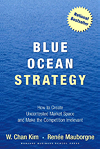Written by two distinguished professors and published in 2005 by Harvard Business Review, Blue Ocean Strategy has made a splash in the business world by challenging the given requirements of strategic success. As companies compete for market share and sustained, profitable growth they fight for the competitive advantage and struggle for differentiation. When companies compete head on, the results are a bloody “red ocean” of rivals fighting over market share in a shrinking profit pool. Kim and Mauborgne contend that this strategy is increasingly unlikely to create profitable growth in the future. Based on extensive research, the authors argue that tomorrows leading companies will succeed not by battling competitors, but by creating “blue oceans” of uncontested market space ripe for growth. They have named their strategy “value innovation” – to create powerful leaps in value for the firm and its buyers, rendering rivals obsolete and unleashing new demand.
The book not only challenges companies but also shows them how to achieve a blue ocean strategy. They introduce a set of analytical tools and frameworks that show you how to systematically head into blue oceans. Kim and Mauborgne elaborate on the principles that define and separate blue oceans strategy from competition-based strategic thought. They use great examples to highlight their points such as the success of Cirque de Soleil as a model of a blue ocean strategy. Their goal is to make the formulation and execution of blue ocean strategy as systematic and actionable as competing in the red waters of a known market space.
Strategy will always involve both opportunity and risk. The authors identify how a company can maximize opportunities while simultaneously minimizing the risks of formulating and executing blue ocean strategies. The six principles and analytical frameworks to succeed in blue oceans:
Formulation principles Risk factor each principle reduces
Reconstruct market boundaries reduces search risk
Focus on the big picture,not the numbers reduces planning risk
Reach beyond existing demand reduces scale risk
Get the strategic sequence right reduces the business model risk
Execution principles Risk factor each principle reduces
Overcome key organizational hurdles reduces organizational risk
Build execution into strategy reduces management risk
The set of analytical tools to assist you include: The Strategy Canvas and The Four Actions Framework. The Strategy Canvas is both a diagnostic and an action framework for building a compelling blue ocean strategy. It serves two purposes. First, it captures the current state of play in the known market space. This allows you to understand where the competition is currently investing, the factors the industry currently competes on in products, service and delivery and what customers receive from the existing competitive offerings on the market. As you plot these points on the x and y axis, you create a value curve. The value curve is the basic component of the strategy canvas as it graphs the company’s relative performance across its industry’s factors of competition. To set a company on a strong, profitable growth trajectory in the face of these industry conditions, it won’t work to benchmark competitors and try to outcompete them by offering a little more for a little less. Such a strategy may nudge sales up but will hardly drive a company to open up uncontested market space. To fundamentally shift the strategy canvas of an industry, you must begin by reorienting your strategic focus from competitors to alternatives, and from customers to noncustomers of the industry.
The Four Actions Framework helps break the trade-off between differentiation and low cost. It also helps create a new value curve. The four key questions to challenge an industry’s strategic logic and business model:
- Which of the factors that the industry takes for granted should be eliminated?
- Which factors should be reduced well below the industry’s standard?
- Which factors should be raised well above the industry’s standard?
- Which factors should be created that the industry has never offered?
When expressed through a value curve, an effective blue ocean strategy has three complementary qualities: focus, divergence and a compelling tagline. Without these qualities, a company’s strategy will likely be muddled, undifferentiated and hard to communicate with a high cost structure. The four actions of creating a new value curve (eliminate, reduce, raise and create) should be well guided toward building a company’s strategic profile with these characteristics. These three characteristics (focus, divergence and a compelling tag line) serve as a litmus test of the commercial viability of blue ocean ideas. When a company’s value curve lacks focus, its cost structure will tend to be high and its business model complex in implementation and execution. When it lacks divergence, a company’s strategy is a me-too, with no reason to stand apart in the marketplace. When it lacks a compelling tagline that speaks to buyers, it is likely to be internally driven or a classic example of innovation for innovation’s sake with no great commercial potential and no natural take-off capability.
It is the intersection between these analytic techniques and the six principles of formulating and executing blue oceans that allow companies to break from the competition and unlock uncontested market space. Many great company examples bring these principles to life throughout the book. The website has a wealth of information and tools for implementation. www.blueoceanstrategy.com. Read the book with a highlighter, work through it with your team and set sail to the blue ocean.



